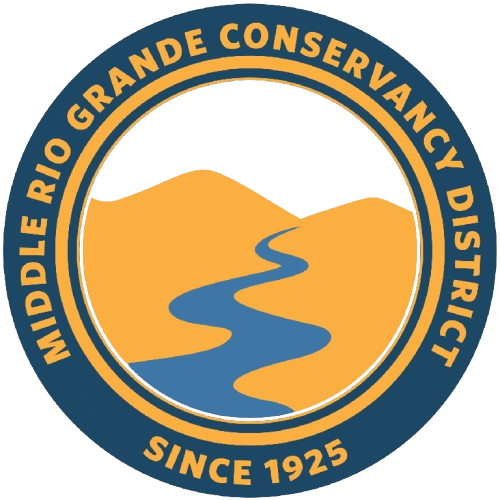Water Managers Brace for Dry Conditions Along Sections of the Rio Grande
Media Contact: Amanda Molina, Middle Rio Grande Conservancy District
Email: amolina@mrgcd.us
Phone: (505) 859-0175
ALBUQUERQUE, N.M. — Water managers across the middle Rio Grande Valley in New Mexico are coordinating efforts in anticipation of a dry 2025 season that will likely cause sections of the river to run dry. In Albuquerque, the Rio Grande remained consistently flowing until 2022, when it dried for the first time in 40 years.
Although agencies are working collectively to mitigate impacts, each faces unique challenges and responsibilities in managing the changing river conditions:
Middle Rio Grande Conservancy District: This year’s below-average snowpack and the District’s inability to store native Rio Grande water have made for a challenging year for farmers in the middle Rio Grande Valley. MRGCD water managers have transitioned into rotational scheduling for all divisions within the Valley; rotational scheduling is in effect during water shortages, with deliveries depending on supply, demand and efficiency. “Our focus remains on maintaining equitable irrigation deliveries throughout the District, which becomes increasingly difficult as water supplies decline. Farmers should prepare for little to no water availability during summer and fall if seasonal rainfall does not return” said Jason Casuga, MRGCD chief engineer and CEO. “Collaboration with other water stakeholder agencies is critical to our operations and our mission.”
Albuquerque Bernalillo County Water Utility Authority: Klarissa Peña, Chair of the Water Authority’s governing board, explained that the use of surface water from the San Juan-Chama Project, delivered via the Rio Grande, is the foundation of the Water Authority’s long-term supply strategy, WATER 2120. “When river flows are low or non-existent, the utility must turn to its groundwater reserves to meet customer demand,” she said. “We are fortunate to have those reserves available, but we must do all we can to save them for use in future droughts. That’s why the sight of a dry river should put all out customers on notice that conservation is just as important as ever.”
The Water Authority is asking users to save water this summer by following the Water by the Numbers program and watering just three days a week in July and August. Customers are also urged to observe time-of-day watering restrictions and only use sprinkler irrigation before 11 AM and after 7 PM; to install rebate-qualified efficient sprinkler components and “smart” controllers; and to shut off sprinkler systems when it rains.
Bureau of Reclamation: At the start of irrigation season, all of Reclamation’s reservoirs along the Rio Chama and Rio Grande were holding less than 15% of their capacity, meaning there was very little water in storage to supplement what will flow through the river this year for irrigation, species benefits, municipalities, and recreation. Despite several large and unexpected storms in May and June that assisted with flows in the Rio Grande, river flow is now declining. River drying on the Rio Grande began on April 16 in parts of the river south of Socorro, New Mexico. While rainstorms have helped the Rio Grande reconnect all the way down to Elephant Butte Reservoir several times since, there are about 20 miles dry south of Socorro as of the first week in July.
Additional monsoon rain could help, but it is likely to be a difficult year for farmers and all water users along the Rio Chama and Rio Grande.
“Reclamation will continue to work closely with the irrigation districts, Pueblos, states, other federal agencies, municipalities, and all other stakeholders to support coordinated water use aimed at achieving multiple benefits whenever possible as this megadrought continues,” said Albuquerque Area Office Manager Jennifer Faler. “We are committed to providing every drop of water available in the most efficient way we can.”
U.S. Fish and Wildlife Service: The Fish and Wildlife Service works with others to conserve, protect, and enhance fish, wildlife, plants, and their habitats for the continuing benefit of the American people. Under the Endangered Species Act, we work to protect and recover imperiled species and the ecosystems upon which they depend. Five threatened and endangered species live in and along the Rio Grande, including the Rio Grande Silvery Minnow. The Fish and Wildlife Service will continue to work with all the partners involved to manage water shortages to minimize effects to the listed species in the Middle Rio Grande. In the circumstance that the Rio Grande does run dry and becomes intermittent, the Fish and Wildlife Service will continue efforts to rescue Rio Grande Silvery Minnow from isolated pools and return them to areas where the river remains continuous.
###
